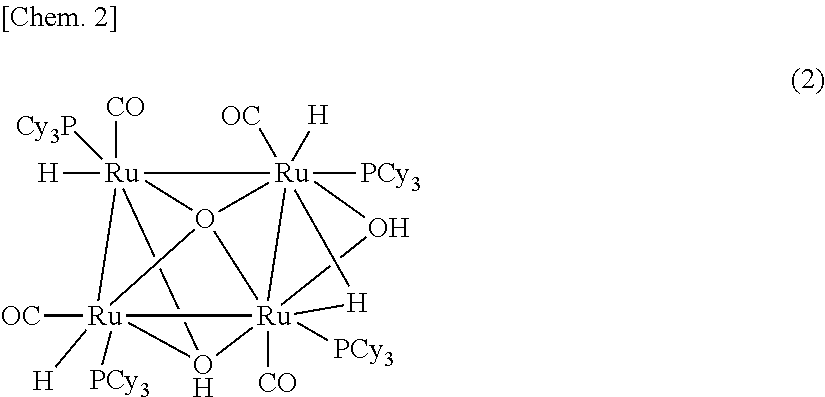Method for producing compound with carbonyl group by using ruthenium carbonyl complex having tridentate ligand as dehydrogenation oxidation catalyst
a carbonyl group and complex technology, applied in the direction of organic compounds/hydrides/coordination complexes catalysts, ruthenium organic compounds, etc., can solve the problems of difficult application to other dehydrogenation oxidation reactions, poor catalyst efficiency, and risk of explosion of martin reagents, etc., to achieve easy production, easy production, easy production
- Summary
- Abstract
- Description
- Claims
- Application Information
AI Technical Summary
Benefits of technology
Problems solved by technology
Method used
Image
Examples
example 1
[0247]The ruthenium carbonyl complex 2 and 1 were produced according to the following reaction scheme.
[0248]
[0249]Under the stream of nitrogen, 4.18 mmol of amine hydrochloride 3 was placed in a 100 mL flask and suspended in 33 mL of toluene, and 14 mL of 15% aqueous NaOH solution was added thereto and the resulting mixture was stirred at room temperature until no solid remained. The resulting solution was separated into an organic phase and an aqueous phase, and the organic phase was washed with 14 mL of distilled water (2 times) and the aqueous phase was subjected to extraction with 14 mL of toluene (2 times). The thus obtained organic phases were combined and dried over sodium sulfate, and then the solvent was distilled off to obtain amine 4.
[0250]4.18 mmol of the ruthenium carbonyl complex 5 was placed in a 200 mL flask, and the flask was purged with nitrogen. Then, the amine 4 dissolved in 33 mL of toluene was added to the flask, and the resulting mixture was heated under reflu...
example 2
Production of 1-octanal
[0256]
[0257]5.9 mg (1 mol %) of the ruthenium complex 1 which has been produced in the Example 1 were added to a 200 mL flask with a branched neck in which boiling chips are added. The flask with a branched neck is purged with nitrogen and 157 μL (1.0 mmol, 130 mg) of 1-octanol was added to the flask. Subsequently, 100 mL (0.01M) of acetone was added thereto. Under nitrogen stream, the mixture was then reacted under stirring with heating in an oil bath which is set at 60 degrees C. As a result of analysis of the reaction solution, it was found that 82% of octanal was produced.
examples 3 and 4
Production of 1-octanal
[0258]1-Octanal was produced with reference to the method described in the Example 1 except that the amount of the catalyst, reaction time, and solvent are changed. The results are given in the following Table 1.
[0259]
TABLE 1ExampleSubstrate1SolventTimeYieldNo.(mmol)(mol %)(ml)(hr)(%)32.50.2Cyclohexanone469(250)42.50.2Cyclohexanone2177(250)
[0260]Apparatus and conditions that are employed for the analysis of the Examples 2 to 4 are as follows.
[0261]GC instrument: Shimadzu GC-2010
[0262]GC: Capillary of Neutra Bond-1
[0263]Injection temperature: 200 degrees C., Detection temperature: 280 degrees C.
[0264]Oven: 40 degrees C. (0 minutes)-100 degrees C. (5 degrees C. / min)-280 degrees C. (10 degrees C. / min)-280 degrees C. (10 minutes)
PUM
| Property | Measurement | Unit |
|---|---|---|
| reaction time | aaaaa | aaaaa |
| reaction time | aaaaa | aaaaa |
| optically active | aaaaa | aaaaa |
Abstract
Description
Claims
Application Information
 Login to View More
Login to View More - R&D
- Intellectual Property
- Life Sciences
- Materials
- Tech Scout
- Unparalleled Data Quality
- Higher Quality Content
- 60% Fewer Hallucinations
Browse by: Latest US Patents, China's latest patents, Technical Efficacy Thesaurus, Application Domain, Technology Topic, Popular Technical Reports.
© 2025 PatSnap. All rights reserved.Legal|Privacy policy|Modern Slavery Act Transparency Statement|Sitemap|About US| Contact US: help@patsnap.com



